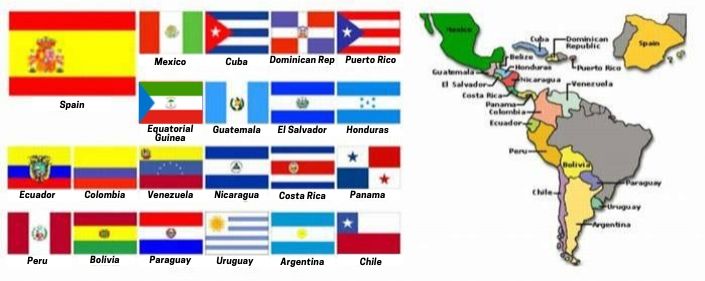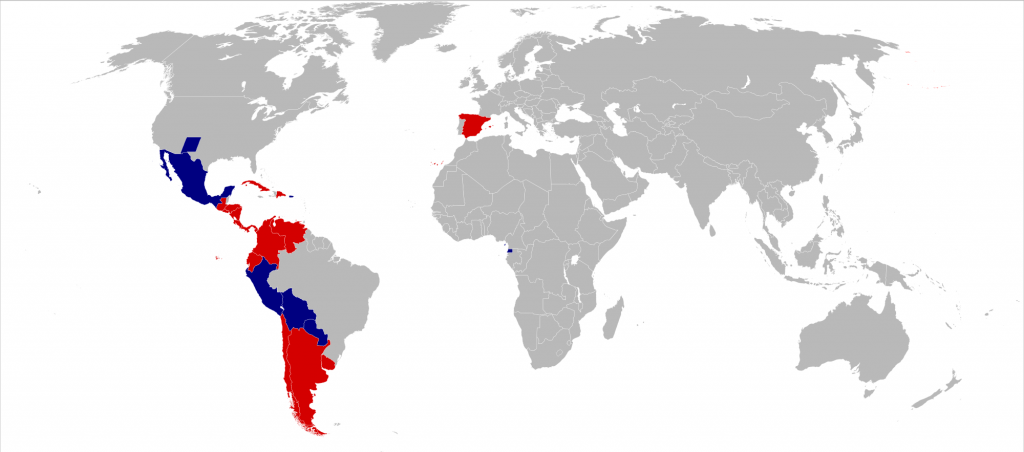Quick! Without looking for too long at the map, can you name all the Spanish speaking countries in the world? I will give you some seconds to think….
Come on the clock is ticking!
Yes, you are right! There are 21 countries!
List of countries where the Spanish is the official language
Most of these countries are located in Central and South America, but also in Africa (Equatorial Guinea, which is not showing on this picture!) and in Europe, Spain

Here you have the complete list of countries with each of their capital cities:
- Argentina – Buenos Aires
- Bolivia – La Paz
- Chile – Santiago
- Colombia – Bogotá
- Costa Rica – San José
- Cuba – Havana
- Dominican Republic – Santo Domingo
- Ecuador – Quito
- El Salvador – San Salvador
- Equatorial Guinea – Malabo
- Guatemala – Guatemala City
- Honduras – Tegucigalpa
- Mexico – Mexico City
- Nicaragua – Managua
- Panama – Panama City
- Paraguay – Asunción
- Peru – Lima
- Puerto Rico – San Juan
- Spain – Madrid
- Uruguay – Montevideo
- Venezuela – Caracas
As you probably know Spanish is also the first language spoken among an important part of the population in the United States, where the percentage of Hispanic population was in 2015 around 17.6 percent according to the United States Census Bureau.
That’s definitely a lot of people! Let’s see how many exactely
Native Spanish speakers
Spanish has overcome English in the world ranking and it is now the second most spoken language in the world after Chinese. There are more than 400 million people who speak native Spanish in the world versus 355 million who speaks native English (These figures are from 2017)
Spanish is the third most used language on the Internet, representing the 8.1% of total users in the world (First is English with 25.3% and second is Chinese with 19.4%) according to the Internet World Stats
English is still the international language, being the most used for business and international relations. It’s also an easy language to learn because its grammar is not as complicated as other Germanic or Romance languages.
The Spanish language falls in the Category I of language difficulty rank for English speakers due to the similarities of pronunciation, grammar and structure, so it’s also one of the easiest languages to learn.
Beyond practical concerns, the opportunities that Spanish offers to discover a vast number of cultures, as well as the business possibilities emerging from new Spanish-speaking markets, consolidate the probability that Spanish will continue to grow as a popular language for learners of all ages.
Is the Spanish language as different as they say from country to country?
It’s true that there are some differences in the Spanish spoken in Buenos Aires from the one spoken in Madrid, but it doesn’t prevent a smooth communication, more the opposite it can create very funny situations. I like to compare it with the differences between the English spoken in London of that spoken in Johannesburg, for instance, it sounds different yet it’s the same language. This makes Spanish a backpacker’s dream, and the starting point for discovering a world of fascinating cultures.
There are numerous funny videos crowding around the Internet with jokes about the weird situations you can find yourself in when using the “improper” odd word in a given country due to the different meaning it might have over there.
My favorite one is the song two Colombian brothers, Nicolás y Juan Andrés Ondina, wrote and performed on YouTube which has nearly 2 millions views!
Don’t wait any longer and start learning Spanish now!
.
Is there a correct Spanish language?
Even though some Spaniards like to think the Spanish from Spain is the correct language because it’s the first one from which all the others originated, this assumption is not correct. Every Spanish spoken in the different countries is legitimate if spoken correctly.
As every other language, Spanish evolves, new words are introduced and others are forgotten for the lack of use. If you want to check if a word is correct or find out more about its exact meaning you may want to check the official sources. The most common are: La Real Academia de la Lengua (RAE), el Instituto Cervantes, Academia mexicana de la lengua and Diccionario panhispanico de dudas. This last one is a joint effort accomplished by the 22 official Spanish language academies in the world, in order to create a reliable source for all the Spanish Speaking countries. The dictionary unifies criteria among the different countries and includes 7,000 words.
Best literature in Spanish
There are hundreds of master pieces of the literature in Spanish, hence the difficulty of choosing just some of them on this list. This journey takes us from the classics of the literature in Spain from the seventeenth century, passing by the magical realism of the Latin american scene in the twentieth century until the excellent contemporary names of our times.
List of excellent books in Spanish
- El Quijote de la Mancha, writen by Cervantes and published in 1605, The story follows the adventures of a noble (hidalgo) named Alonso Quixano who reads so many chivalric romances that he loses his sanity and decides to set out to revive chivalry, undo wrongs, and bring justice to the world, under the name Don Quixote de la Mancha. He recruits a simple farmer, Sancho Panza, as his squire, who often employs a unique, earthy wit in dealing with Don Quixote’s rhetorical orations on antiquated knighthood. Don Quixote, in the first part of the book, does not see the world for what it is and prefers to imagine that he is living out a knightly story.
- El árbol de la vida, written by Pio Baroja in 1911, The first part of the novel deals with the life of the medicine student Andrés Hurtado. Through his family, teachers, classmates and diverse friends, Baroja draws a merciless painting of the bourgeois and proletarian 19th century inhabitants of Madrid
- Bodas de sangre, is a tragedy by Spanish dramatist Federico García Lorca. It was written in 1932 and first performed at Teatro Beatriz in Madrid in March 1933, then later that year in Buenos Aires, Argentina. Theatre critics often group Blood Wedding with Lorca’s Yerma and The House of Bernarda Alba as the “rural trilogy”. Lorca’s planned “trilogy of the Spanish earth” remained unfinished at the time of his death, as he did not include The House of Bernarda Alba in this group of works.[1]
- Cien años de soledad, is a landmark 1967 novel by Colombian author Gabriel García Márquez that tells the multi-generational story of the Buendía family, whose patriarch, José Arcadio Buendía, founds the town of Macondo, a fictitious town in the country of Colombia.The magical realist style and thematic substance of One Hundred Years of Solitude established it as an important representative novel of the literary Latin American Boom of the 1960s and 1970s,[1] which was stylistically influenced by Modernism (European and North American) and the Cuban Vanguardia (Avant-Garde) literary movement.
- Los renglones torcidos de Dios, is a novel published in 1979 by Torcuato Luca de Tena. It tells the story of Alice Gould, a detective who goes into a psychiatric hospital following the clues referring to a murder case. In order to adequately document himself, the author was hospitalized for 18 days in a psychiatric institution, where he lived directly with mental patients that served as the basis for the creation of the characters of the work.
- La fiesta del chivo, The Feast of the Goat (Spanish: La fiesta del chivo, 2000) is a novel by the Peruvian Nobel Prize in Literature laureate Mario Vargas Llosa. The book is set in the Dominican Republic and portrays the assassination of Dominican dictator Rafael Trujillo, and its aftermath, from two distinct standpoints a generation apart: during and immediately after the assassination itself, in May 1961; and thirty-five years later, in 1996. Throughout, there is also extensive reflection on the heyday of the dictatorship, in the 1950s, and its significance for the island and its inhabitants.
- La casa de los espíritus, is the debut novel of Isabel Allende. The novel was rejected by several Spanish-language publishers before being published in Buenos Aires in 1982. The book was first conceived by Allende when she received news that her 100-year-old grandfather was dying. She began to write him a letter that ultimately became the manuscript of The House of the Spirits.[5]The story details the life of the Trueba family, spanning four generations, and tracing the post-colonial social and political upheavals of Chile – though the country’s name, and the names of figures closely paralleling historical ones, such as “the President” or “the Poet”, are never explicitly given. The story is told mainly from the perspective of two protagonists (Esteban and Alba) and incorporates elements of magical realism.
- Corazón tan blanco, by Javier Marías, is a novel about secrecy, or, said with less elusive words, about the need for deception and lies in relationships. And it is a novel, like all of Marias’, about the way in which chance or fatality – “I did’t want to know, but I have known”, he says in the prodigious start of the book – build our lives.
There are hundreds of excellent books which have shaped the history of Spanish literature but we cannot name them all.
What is your favorite book in Spanish? Leave us a comment here!




